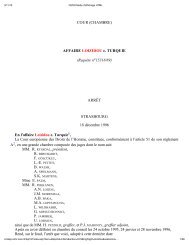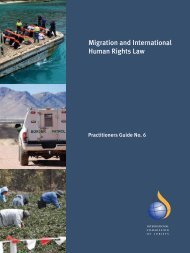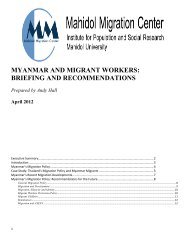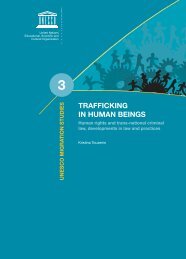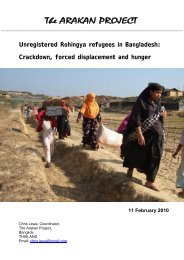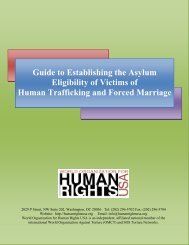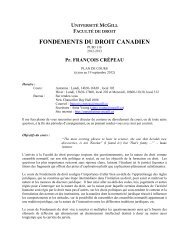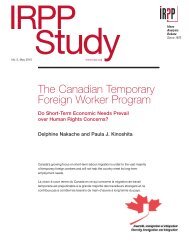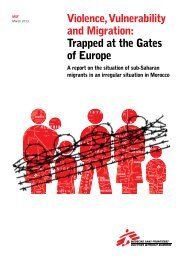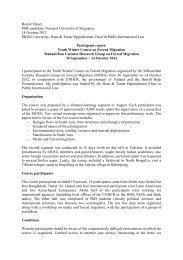Access to Justice for Migrant Workers in BC - West Coast Domestic ...
Access to Justice for Migrant Workers in BC - West Coast Domestic ...
Access to Justice for Migrant Workers in BC - West Coast Domestic ...
Create successful ePaper yourself
Turn your PDF publications into a flip-book with our unique Google optimized e-Paper software.
PART TWO<br />
Literature Review and Analysis of Program<br />
Part One of the paper established how the TFWP fits <strong>in</strong><strong>to</strong> a global phenomenon of<br />
<strong>in</strong>creased reliance of OECD countries on impermanent import<strong>in</strong>g of <strong>for</strong>eign workers <strong>in</strong><br />
lower skilled positions and described the ma<strong>in</strong> immigration options available <strong>to</strong> migrant<br />
workers <strong>in</strong> the NOC C and D categories. Part Two will provide a brief review of the literature<br />
analyz<strong>in</strong>g the TFWP and the impact of its regulations on migrant workers.<br />
There has been a grow<strong>in</strong>g emphasis amongst researchers, advocacy organizations and<br />
field practitioners about the l<strong>in</strong>kages between the precarious immigration status of lowerskilled<br />
temporary migrant workers, the precarious nature of the work, and how<br />
precariousness impacts the en<strong>for</strong>cement employment standards. Judy Fudge identifies a<br />
nexus between precarious immigration status and precarious employment status, <strong>in</strong> which<br />
the regulations used <strong>to</strong> control migration ensures temporary <strong>for</strong>eign workers are not secure<br />
<strong>in</strong> their employment and thus impacts their ability <strong>to</strong> demand decent wages, work<strong>in</strong>g and<br />
liv<strong>in</strong>g conditions, and the right <strong>to</strong> organize. 46 This situation feeds <strong>in</strong><strong>to</strong> the employment<br />
market <strong>in</strong> general, creat<strong>in</strong>g a downward pressure on employment standards.<br />
Precarious employment is unstable and <strong>in</strong>secure. Vosko def<strong>in</strong>es it as “work <strong>for</strong><br />
remuneration characterized by uncerta<strong>in</strong>ty, low <strong>in</strong>come, and limited social benefits and<br />
statu<strong>to</strong>ry entitlements.” 47 Precarious immigration status fosters precarious employment<br />
because the temporary <strong>for</strong>eign worker’s ability <strong>to</strong> rema<strong>in</strong> <strong>in</strong> Canada is heavily reliant on the<br />
employer and workers fear<strong>in</strong>g <strong>for</strong> their immigration status will be less likely <strong>to</strong> demand<br />
better employment standards. Indeed, most TFWP work permits are employer specific,<br />
ty<strong>in</strong>g the worker <strong>to</strong> one employer, thereby shift<strong>in</strong>g the power imbalance and reliance<br />
further <strong>in</strong> favor of the employer.<br />
The tied nature of the work permits has led <strong>to</strong> the development of the notion of<br />
“unfree” workers. 48 <strong>Migrant</strong> workers on employer specific work permits do not have the<br />
same labour mobility as citizens or permanent residents. Under Canada’s immigration laws,<br />
they must seek a new work permit if they wish <strong>to</strong> change employers. The idea of “unfree”<br />
workers, which perpetuates precariousness, has been l<strong>in</strong>ked <strong>to</strong> the erosion of labor<br />
standards <strong>in</strong> the work<strong>for</strong>ce and some academics have op<strong>in</strong>ed that it has caused the<br />
cluster<strong>in</strong>g of migrant workers <strong>in</strong> particular <strong>in</strong>dustries where en<strong>for</strong>cement of employment<br />
46<br />
Judy Fudge, “Precarious <strong>Migrant</strong> Status and Precarious Employment: The Paradox of International Rights <strong>for</strong> <strong>Migrant</strong> <strong>Workers</strong>,”<br />
Comparative Labor Law and Policy Journal 34, no. 1 (2012), 100, http://he<strong>in</strong>onl<strong>in</strong>e.org.ezproxy.library.ubc.ca/HOL/Page<br />
handle=he<strong>in</strong>.journals/cllpj34&collection=journals&page=95.<br />
47<br />
Leah Vosko, Manag<strong>in</strong>g the marg<strong>in</strong>s: gender, citizenship, and the <strong>in</strong>ternational regulation of precarious employment (Ox<strong>for</strong>d,<br />
Ox<strong>for</strong>d University Press: 2010), 103.<br />
48<br />
Fay Faraday, Made <strong>in</strong> Canada: How the Law Constructs <strong>Migrant</strong> <strong>Workers</strong>’ Insecurity, (Metcalfe Foundation, 2012), 26, http://<br />
metcalffoundation.com/wp-content/uploads/2012/09/Made-<strong>in</strong>-Canada-Full-Report.pdf.<br />
18



